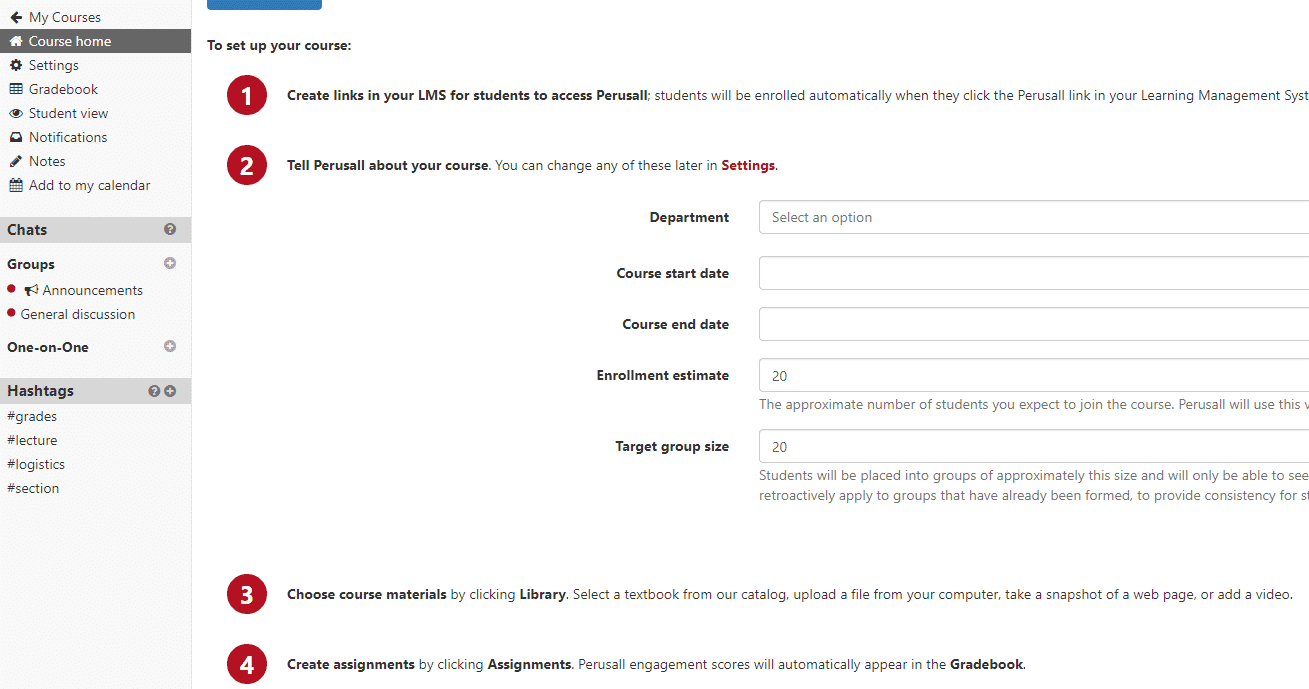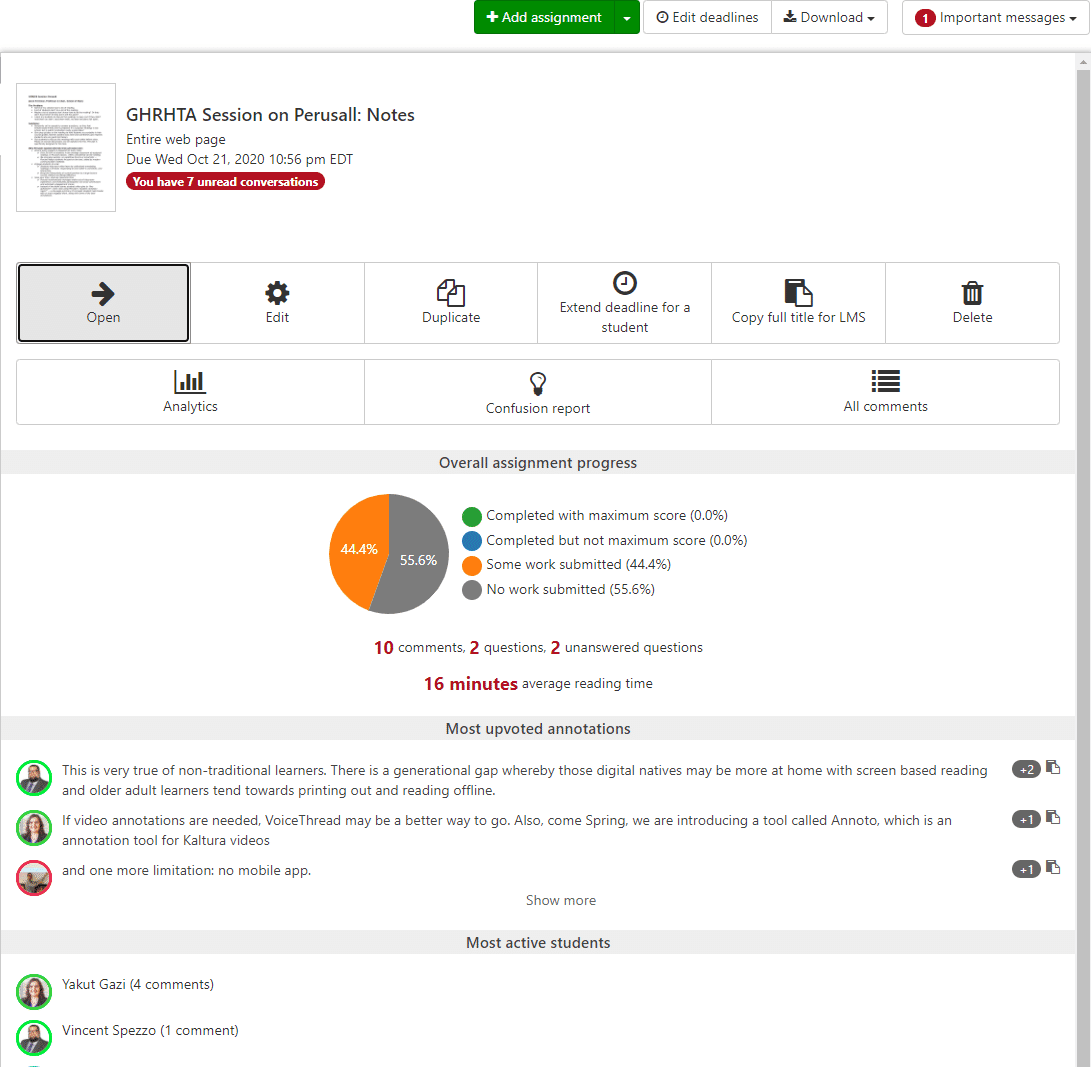In this module, you will learn how to use Perusall, a social annotation tool, to turn the usually-solitary act of reading or video watching into an engaging learning experience by enabling students to interact with their course content, teachers, and peers.
Why Social Annotation?
To many students, reading or watching course videos is usually a chore.
How could we turn such assignments into a more meaningful learning activity? How might social annotation improve your students' learning and increase the sense of community in your class?
Traditionally we assign readings to students and tell them to go over to the discussion forum, post their reflection on their reading, and reply to posts from other students. With web-based tools for social annotation, this read-reflect-discuss process is no longer separated. Students are able to annotate in digital texts, or even digital media such as videos, and anchor a group discussion on the annotated information. Social annotation provides students opportunities to deeply engage with readings or other course materials. Students interact with their peers, using skills necessary for inquiry learning and collaborative learning.
Key features of social annotation tools often include collaborative/individual annotating, highlighting, tagging, color-coding, filtering, and annotation recommendation. In this module, you will learn how to use a social annotating tool, Perusall, to create engaging learning experiences.
How Does Perusall Work?
Perusall is a social annotating tool integrated with Canvas. It is not enabled by default. To enable it, log on to your Canvas course site, go to Settings >> Navigations, drag and drop it to the active tool list, and save the change.
The video tutorial below will give you an overview of how Perusall works:
What Can You Do with Perusall?
Set Up Perusall in Canvas
- Add Perusal to Your Canvas Course Site

The first step to set up Perusall in Canvas is to add Perusall to your course site. It is the same process as what you would do to enable a non-default tool in Cnavas: go to Settings >> Navigation, drag and drop Perusall from the disabled tool list to the enabled tool list above, and save the change.
Perusall will appear on the left course menu after it is enabled. Clicking it will open Perusall on a new tab. The screenshot above shows what you will see when you open Perusall for the first time - it lists four steps for setting up your course.
By enabling Perusall in Canvas and adding it to the course menu, you completed Step 1, Create links in your LMS for students to access Perusall. Your students can access Perusall by selecting it from the menu.
- Tell Perussal About Your Course

Step 2 asks you to enter some information about your course:
- Department
- Course start date
- Course end date
- Enrollment estimate
- Target group size
The information you provide now can be changed at any time in Settings, if they need to be updated. Please note that there is a generic welcome message for students (click to zoom the above screenshot of the message to view the details). While it may contain useful information from Perusall, you can customize it as needed or add other information that you think your students should know about.
- Add Course Materials to the Library
When you create a Perusall assignment, you must select content for students to read/watch/listen to. Therefore, at least one item must be added to your library tab before creating an assignment.
You can upload a variety of files and media for students to read and annotate. A single assignment can include different types of content, e.g. an article and a video. You can also use textbooks with Perusall.
If you want students to provide materials for annotating, you may create a Student Upload Folder to allow them to upload their materials. Then when you create assignments, you choose the materials from this folder.
How do I add, edit, or delete a document?
How do I use Podcast in Perusall?
How do I use video in Perusall?For other questions regarding using content in Perusall, please refer to a collection of related FAQs.
- Create an Assignment
To create an assignment, you click to open the Assignments tab on the top of the Perusall home page, and you will see a green button, Assign assignment. There is a drop-down list next to this button, which gives you two options:
- Add assignment - You will create an assignment in which students will annotate the same materials.
- Add differentiated assignment - You will create an assignment and assign different materials to different students for annotating. Before you create this assignment, you need to create a folder in the library and upload all the materials so that you can assign them to students for this assignment.
Creating an assignment involves the following three components:
- Content: You select the content for the assignment, i.e., what will students annotate?
- Options: You decide when the assignment is due and how students are expected to do for this assignment. You can also choose whether the annotating is anonymous and whether the assignment is optional.
- Scoring: You decide whether to use the course default scoring setting or to customize scoring settings for this assignment.
Here are instructions on how to create assignments in Perusall:
How do I create, edit, or delete an assignment?
How do I create assignments that include multiple sections or page ranges?
Can I create different assignments for different students?For other questions regarding how to manage assignments, please refer to the assignment FAQs.
Manage Assignments in Perusall

Other features are also available for you to manage the annotating assignments. Please see below for a summary of what you can do with these features:
- Manage Grouping
Perusall automatically groups students in the course for annotating. By default, each group is assigned with about 20 students. You can change the number in the course settings. You may also create groups in Canvas and use them for the Perusall assignments. Students will only see the comments that are made by the instructor and other students in their group.
The video tutorial below explains how groups work in Perusall. You may also refer to the documentation below for more details:
- Enable/disable assignment reminders
Email notifications are enabled by default. You may disable the reminder and your students can also opt out of receiving them. The link below directs you to instructions on enabling or disabling the assignment reminders.
Does Perusall remind students when their assignments are due?
- Make annotating anonymous
Students have the option of posting comments anonymously, which means their identity will be hidden from other students, but not the instructor. If you mark an assignment as "fully anonymous", then students can only post comments anonymously. The link below directs you to instructions on how to make annotating anonymous:
- Use Hashtags
Hashtags are a way for students to tag annotations based on keywords that are of interest to them (or you). Like on a social network, a student adds a hashtag by typing the hash symbol (#) and then any word or phrase without spaces, e.g., #Vaccination.
- Post comments and questions directed to students
You can add questions or comments the same way that students do. Yours will be highlighted blue while students' yellow. You may also upvote students' annotations as a way to endorse good questions or answers.
- Preview Perusall from student view
Clicking the Student View link in the left navigation panel of your course allows you to see exactly how students will experience Perusall.
How do I preview what Perusall looks like from the student perspective?
- Allow students to download the readings
For materials that have no copyright restrictions, you may allow students to download them.
Grade Perusall Assignments
Grading is enabled automatically when there are at least 15 students participating in the course. If you have smaller classes, request grading from Perusall Support (support@perusall.com).
Student work in Perusall is graded automatically, but you always have full control and can override the annotation scores provided by Perusall. You can learn how the Perusall auto grading works by taking a look at the criteria that Perusall uses to define annotation quality.
You can also use threshold grading to simply give students credit or no credit for the assignments.
Perusall has a gradebook and it shows you the grades of the Perusall assignments. Students won't see them until you release them. If you link the Perusal assignments to a Canvas assignment, the grades will be posted to the Canvas gradebook.
Strategies for Using Perusall Effectively
- Adjust group size accordingly
Persuall automatically groups students for annotating and the default group size is 20 students. Based on your course enrollment or the nature of the assignment, you may adjust the group size accordingly.
- Provide scaffolding question prompts
Students may find their reading being impeded and distracted by irrelevant annotations. Providing them with question prompts, reading strategies or guidance will help students stay focused on their reflection and critiques.
- Decide the level of instructor involvement
In terms of instructor involvement, more is not always better. Facilitation is necessary to enhance discussion quality and interaction. You may also help clarify when you see annotations /comments that could mislead students. However, make sure that your involvement would not dominate the discussions.
- Review confusion report
This report automatically generated by Perusall will help you get an idea about what questions were asked by students and what appears confusing to students based on the annotations.
- Provide students with support resources
Here are the support resources that you can direct your students to before using Perusall in your class:
- Perusall student guide
- A one-page rubric that explains what Perusall is, how it works, and how annotations are graded, as well as a set of example annotations with associated scores.
- Perusall support email: support@perusall.com
Recommended Resources
- Perusall Instructor Guide: A list of FAQs categorized by courses, Content, Assignments, as well as Scoring and Grades.
- Perusall Student Guide: A list of FAQs on how to get started and how to annotate assignments.
- Contact Perusall Support: Submit your request to support@perusall.com or fill out the request form.
- Teaching with Perusall and Social Annotation - Highlights from a Conversation - This is a blog post published on September 23, 2020, highlighting the takeaways from instructors from different disciplines at Vanderbilt University who used Perusall for social annotation in their teaching.